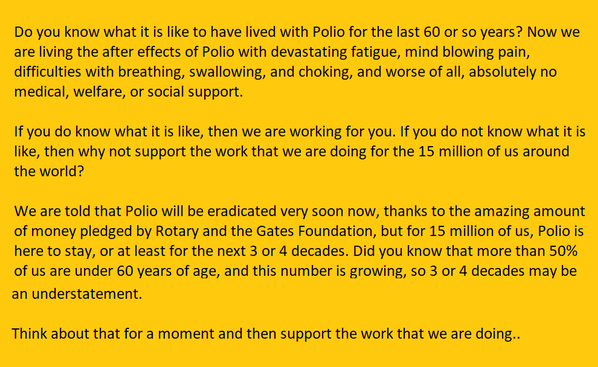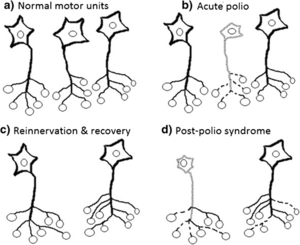Post-Polio Syndrome
Living with Post-Polio Syndrome[edit | edit source]
When we left hospital after contracting Polio, ( know as Infantile Paralysis many years ago ), regardless of the disabilities bequeathed us by the Polio Virus, the last thing told us by our attending Physician, now burnt into our memory was "You must use it, or lose it"
How wrong was this statement, and since that fateful day we have been unwittingly destroying, or further damaging, already seriously damaged motor neurons, to such a degree that almost 70% of Polio Survivors are now experiencing one of the most devastating debilitating neurodegenerative condition in the world.
Non-motor symptoms of PPS have considerable quality of life implications and are notoriously challenging to manage, and yet very few Medical Professionals have even a slight knowledge of Polio, and even less of PPS.
Every person who was caught by the Polio virus had damage to 98% of their motor neurons, with these motor neurons receiving either a minimum of 58% damage, or total destruction.
Many Polio victims were never diagnosed as their symptoms could have been only 'flu like' and would have gone unnoticed
Even those of us who had 58% of our motor neurons damaged would never be paralyzed.
Our parents were told that our recovery was stable and once our muscle strength and physical abilities returned, they will remain stable for the rest of our lives, in fact we developed unexpected and disabling symptoms about 35 years after the acute polio virus attack.
Post-Polio Syndrome or Post-Polio Sequelae symptoms:
- 91% - Fatigue
- 82% - Muscle Weaknes
- 76% - Muscle Pain
- 75% - Joint Pain
- 60% - Cold Intolerance
- 50% - Sleep Disorders
- 15% - Difficulty Swallowing
- 5% - Breathing Issues
If a Polio Survivor has total paralysis at the time of the virus attack, but has very limited paralysis when leaving hospital, they will in all probability suffer the most serious effects of Post-Polio Syndrome, and vice-versa. This is generally thought to be the case because the enormous number of sprouts formed to replace or repair the virus damaged motor neurons would be only 'temporary', and with normal or excessive wear, would not last beyond 30 or so years after the initial attack, thus the greatest effects of PPS.
At the time of the initial attack parents of Polio Survivors were told that they would die, stop breathing, or never walk again, but in the vast majority of cases this was not the case.
For some strange reason, we were told that:
- We would never go to college
- We would never get a job, and
- We would never get married.
To be accepted, Polio Survivors became 'Type A' personalities, with the feeling of loneliness, and have a lower sense of adequacy, worth, and value.
We were told to 'get normal', and so:
- We discarded assistive devices
- We have more years of education
- We work more overtime hours and take fewer sick days
- The rate of employment and annual income is the same as non-disabled workers, and are unrelated to the severity of our disabilities
- We married at a higher rate
- We are 15% more sensitive to criticism and failure, and 30% more 'Type A'
The polio virus actually entered and damaged the brain first, whether or not it entered the spinal cord....
Fatigue is the number 1 reported PPS, brain fatigue associated with:
- Reported difficulty with concentration, memory, attention, word finding and staying awake
- Abnormal attention, word finding and slowed thinking speed on neuropsychologic tests
- Brain wave slowing
- Other PPS "brain" symptoms evident: Abnormal breathing ( 50% ), and Twitching in sleep ( 33% )
What then must Polio Survivors do?[edit | edit source]
[1][edit | edit source]
- ↑ Dr. Richard Bruno -The Polio Paradox








